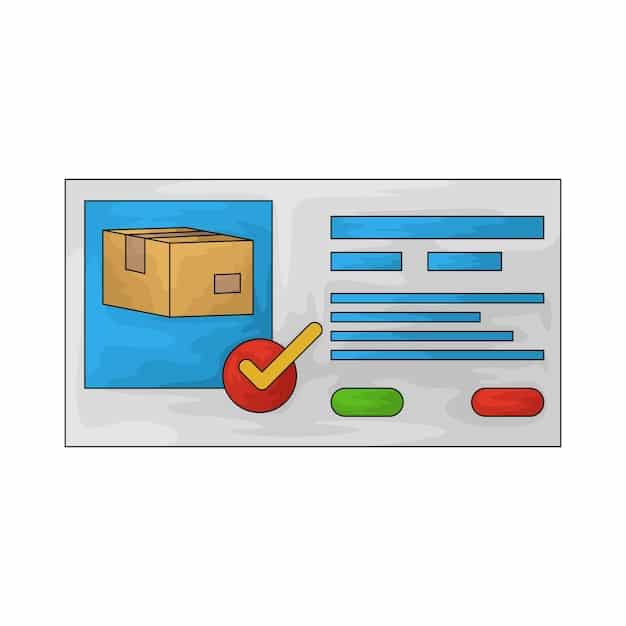Japanese Online Shopping 2025: US Residents’ Guide to Shipping & Customs

Japanese online shopping for US residents in 2025 requires understanding shipping options, customs duties, and payment methods to ensure a smooth and cost-effective experience.
Dreaming of snagging unique Japanese goods without hopping on a plane? Japanese online shopping for US residents: Navigating shipping, customs, and payment options in 2025 is easier than ever, but understanding the nuances is key. This guide will arm you with everything you need for a seamless shopping spree from the Land of the Rising Sun.
Navigating the World of Japanese E-Commerce from the US
Japanese e-commerce offers a treasure trove of unique items, from anime merchandise to traditional crafts. But how do you, as a US resident, dive into this world? This section breaks down the essentials, paving the way for a smooth start to your online shopping journey.
Popular Japanese Online Marketplaces
Knowing where to shop is half the battle. Here are a few popular marketplaces:
- Rakuten Japan: A massive online retailer offering everything from electronics to fashion.
- Amazon Japan: Similar to the US version, with a wide selection and familiar interface.
- Yahoo! Auctions Japan: A great place to find rare or vintage items, but requires some Japanese language knowledge.
- Mercari Japan: A popular flea market app with unique fashion items.
Choosing the right marketplace is the first step to success. Rakuten and Amazon Japan offer the broadest selection, while Yahoo! Auctions and Mercari Japan cater to more niche interests. Make sure to research each platform to find the one that best suits your needs and language skills.

Essential Tools for Browsing
Overcoming the language barrier is crucial. Consider these tools:
- Google Translate: For quick translations of product descriptions and website navigation.
- Chrome’s built-in translation: Offers automatic website translation.
- Japanese-English dictionaries: For more accurate and nuanced translations.
These tools will transform your shopping experience, allowing you to browse with confidence and understand product details. Don’t hesitate to utilize a combination of resources to ensure clarity and accuracy.
Entering the Japanese e-commerce market from the US might seem daunting at first, but with the knowledge of popular marketplaces and available translation tools you’re well on your way to a successful shopping experience.
Understanding Shipping Options from Japan to the US
Shipping from Japan can be a bit more involved than domestic shipping. This section explores the different shipping options available and what you need to consider when choosing one.
Available Shipping Methods
Several shipping methods are available, each with varying speed and cost:
- EMS (Express Mail Service): Fast and reliable, typically taking 3-7 days.
- Airmail: Slower than EMS, but more affordable, taking 6-14 days.
- Surface Mail (Sea): The cheapest option, but can take several weeks or even months.
- DHL/FedEx: Private courier services, offering fast and trackable shipping, but at a higher cost.
Choosing the right method depends on your budget and how quickly you need your items. EMS is ideal for urgent purchases, while surface mail is suitable for non-urgent, bulky items. Consider the pros and cons of each option before making a decision.
Calculating Shipping Costs
Shipping costs depend on several factors:
- Weight and dimensions of the package.
- Shipping method chosen.
- Destination address in the US.
- Insurance and tracking options.
Always check the shipping costs before finalizing your purchase. Many websites offer shipping calculators to help you estimate the total cost. Remember to factor in potential customs duties and taxes as well.
Understanding shipping methods and associated costs is essential for a cost-effective shopping experience. Carefully evaluate your options and budget before making a final decision.
Decoding Customs Duties and Import Taxes
Navigating customs can be tricky. Understanding duties, taxes, and import regulations is vital to avoid unexpected fees and delays.
US Customs Regulations
The US Customs and Border Protection (CBP) regulates imported goods. Key points to note:
- De Minimis Value: Shipments valued under $800 USD generally enter the US duty-free.
- Restricted Items: Certain items are prohibited or require special permits. Check the CBP website for a list of restricted items.
- Accurate Declarations: Ensure the seller accurately declares the contents and value of your package.
Staying informed about CBP regulations will help you avoid potential issues. Familiarize yourself with the de minimis value and restricted items list to ensure a smooth customs clearance process.

Calculating Import Duties and Taxes
If your shipment exceeds the de minimis value, you may be subject to duties and taxes. These are typically calculated as a percentage of the item’s value and vary depending on the product category. Use online duty calculators to estimate potential costs.
Understanding potential import duties and taxes is crucial for budget planning. Utilize online resources and communicate with the seller to get an accurate estimate of these costs.
Customs duties and import taxes are an important consideration for Japanese online shopping. By understanding the regulations and calculating potential costs, you can avoid surprises and ensure a smooth import process.
Mastering Payment Methods for Japanese Online Stores
Payment methods can vary across different Japanese online stores. Knowing your options and their security is crucial for a safe transaction.
Common Payment Options
Explore these payment methods commonly accepted:
- Credit Cards: Visa, Mastercard, and American Express are often accepted, but check beforehand.
- PayPal: A secure and convenient option, but may incur currency conversion fees.
- Bank Transfer: Less common for international transactions, but may be an option for larger purchases.
- Convenience Store Payments (Konbini): Generally not available for international shoppers.
Choose the payment method that best suits your needs and offers the most security. Credit cards and PayPal are generally the safest and most convenient options for international shoppers. Be sure to check the store’s accepted payment methods before proceeding with your purchase.
Currency Conversion and Fees
Be aware of currency conversion rates and potential fees. Credit card companies and PayPal may charge fees for converting USD to JPY. Compare rates and fees to minimize costs. Consider using a credit card with no foreign transaction fees.
Minimizing currency conversion fees can save you money. Compare rates from different payment providers and choose the option that offers the best value.
Understanding payment methods, currency conversion rates, and associated fees is crucial for a cost-effective and secure shopping experience. Choose your payment method wisely and be mindful of potential costs.
Avoiding Scams and Ensuring Secure Transactions
Online security is paramount. Learn how to spot scams, protect your personal information, and ensure secure transactions.
Red Flags to Watch Out For
Be wary of these red flags:
- Unbelievably low prices: If it seems too good to be true, it probably is.
- Unsecure websites (no “https” in the URL).
- Requests for personal information via email.
- Sellers with no reviews or a history of negative feedback.
Staying vigilant will help you avoid scams and protect your personal information. Trust your instincts and avoid deals that seem suspicious.
Tips for Secure Shopping
Follow these best practices for secure online shopping:
- Use strong, unique passwords for all your online accounts.
- Keep your antivirus software up to date.
- Shop on secure websites with “https” in the URL.
- Read reviews and check the seller’s reputation before making a purchase.
Prioritizing online security will safeguard your personal and financial information. Implement these best practices to ensure a safe and worry-free shopping experience.
Staying safe and avoiding scams is paramount. By recognizing red flags and following secure shopping practices, you can confidently enjoy your Japanese online shopping experience.
Staying Updated on Changes in 2025
The e-commerce landscape is constantly evolving. Stay informed about potential changes in shipping regulations, customs policies, and payment options.
Following Industry News
Keep abreast with the latest developments:
- Subscribe to newsletters from reputable e-commerce platforms.
- Follow relevant blogs and news websites.
- Join online communities and forums dedicated to Japanese online shopping.
Staying informed will help you adapt to changes and optimize your shopping strategy. Proactively seek out information from reliable sources to stay ahead of the curve.
Adapting to New Trends
Be open to new technologies and trends, such as:
- Emerging payment methods like cryptocurrency.
- Developments in shipping technology and logistics.
- Changes in customs regulations and international trade agreements.
Adapting to new trends will ensure you can leverage the latest opportunities and navigate any challenges that may arise. Embrace innovation and continuously refine your approach to Japanese online shopping.
The world of e-commerce is consistently changing. Keeping up-to-date with news, adapting to trends will give you an advantage as Japanese online shopping for US residents: Navigating shipping, customs, and payment options in 2025 continues to evolve.
| Key Point | Brief Description |
|---|---|
| 🛒 Marketplaces | Explore Rakuten, Amazon Japan, and more. |
| 🚢 Shipping | Choose from EMS, Airmail, or Surface Mail. |
| 💰 Customs | Be aware of US customs regulations and potential duties. |
| 🔒 Security | Watch out for scams and use secure payment methods. |
FAQ
▼
The de minimis value is $800 USD. Shipments valued under this amount generally enter the US duty-free, simplifying the import process for smaller purchases.
▼
EMS (Express Mail Service) and private couriers like DHL/FedEx offer the fastest delivery times, typically ranging from 3-7 days depending on the destination.
▼
Be cautious of unusually low prices, unsecure websites, and requests for personal information. Always check seller reviews and use secure payment methods like PayPal or credit cards.
▼
Credit cards like Visa and Mastercard, and PayPal are commonly accepted. Bank transfers are less frequent. Convenience store payments or Konbini are generally not available for international shoppers.
▼
Import duties are based on a percentage of item’s value. Online duty calculators can provide an estimation. Contact the seller of possible costs involved in importing to the US.
Conclusion
Navigating Japanese online shopping for US residents: Navigating shipping, customs, and payment options in 2025 requires careful planning and awareness of various factors. By understanding shipping options, customs duties, payment methods, and security measures, you can shop confidently and enjoy unique Japanese products from the comfort of your home.





